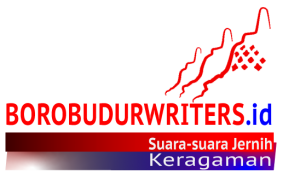Borobudur festival puts spotlight on pluralism

The 6th Borobudur Writers and Cultural Festival (BWCF) opened on Thursday in Yogyakarta with a theme that focuses on Borobudur temple’s Gandawyuha reliefs. (JP/Tarko Sudiarno)
The 6th Borobudur Writers and Cultural Festival (BWCF) opened on Thursday in Yogyakarta with a theme that focuses on Borobudur temple’s Gandawyuha reliefs.
Gandawyuha, the name of the reliefs on the walls of Borobudur’s second, third and fourth levels, centers on the story of a young man, Sudhana, who travels across India in search of the ultimate truth.
During his travels, he meets 53 gurus before meeting Bodhisatwa Samanthabadra, one of three bodhisattvas in Mahayana Buddhism tradition who, together with the other two bodhisattvas, Manjusri and Avalokikitesvara, represent the essence of Buddha’s character.
Catholic priest Mudji Sutrisno SJ said that, in his search for the ultimate truth, Sudhana met monks, nuns, traditional physicians and a high-class prostitute named Vasumitra, showing that the truth in the Gandawyuha perspective could come from anywhere in society.
“That was why BWCF considered Gandawyuha reliefs as one of the oldest references on tolerance and pluralism in Indonesia,” said Mudji, who delivered the opening speech at the festival along with archeologist Agus Widyatmoko.
A curator at the festival, Seno Joko Suyono said the annual event, first held in 2012, would run until Saturday at Borobudur temple in Magelang regency, Central Java as well in Yogyakarta.
He said the festival’s curators considered the reliefs as the “core” of Borobudur. “It’s very important to understand and study them because only by reading them can we really understand the deepest meaning behind the development of the temple,” Seno said.
He said the theme was chosen because there were no symposiums or seminars that specifically focused on Gandawyuha, a situation he attributed to archaeologists having primarily studied the reliefs from a physical perspective as opposed to studying its literary roots.
Mudji said Gandawyuha was the last section of Avatamsaka, a sutra (sacred text) carved on 460 reliefs of Borobudur, thus dominating the temple’s reliefs.
“So it’s very surprising Gandawyuha has never been seriously discussed,” said Mudji, a professor in philosophy at the Driyarkara College of Philosophy and festival consultant.
For the event, the organizing committee also invited researchers of local faiths, such as the Kaharingan, Marapu, Parmalin, Sumarah, Sunda Wiwitan faiths, to talk about similarities among the faiths’ interpretations of the spiritual journey.
Their presence in the festival, attended by some 250 participants this year, is timely as local faiths were recently recognized by the Constitutional Court.
The three-day festival offers various programs, including a morning meditation session at the foot of Borobudur led by three different instructors: Buddhist priest Santachitto leads a 30-minute sitting meditation, Jesuit priest Sudrijanto SJ teaches a 30-minute peace walk meditation and seasoned yoga instructor Yudhi Widiantoro offers 60-minute sunrise yoga.
Mahayana Buddhism expert Salim Lee is scheduled to talk about the Gandawyuha reliefs on Friday afternoon, while on Saturday morning he will take participants on walks through the temple to directly read the reliefs.
“I think reading reliefs directly from the temple like this has rarely been done. It’s therefore not surprising if not many people know about what the reliefs on levels two, three and four talk about,” Seno said.
Other programs include seminars, public speeches, exhibitions, documentary film screenings and arts and cultural performances.
Two documentaries, Hari Suryanto’s Swarnadwipa and Naswan Iskandar’s Sunyata: Mahavihara Muarajambi, are to be screened on Saturday. Both documentaries explore the Muarajambi site in Jambi, Sumatra Island, where noted Buddhist priest Atisha from India gained knowledge on Mahayana Buddhism teachings from a local guru named Serlingpa aka Dharmakirti.
Old manuscripts from Bali featuring the collections of KRT Manu W. Jayaatmaja Wangsawikrama, a senior Javanese manuscript expert of Gadjah Mada University (UGM), are on display in an exhibition open from Thursday to Saturday.
SRI WAHYUNI (THE JAKARTA POST)
Yogyakarta | Fri, November 24, 2017 | 09:18 am




